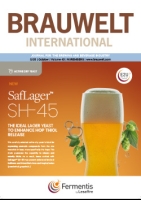According to latest figures released by beer market specialists Plato Logic, the World Beer market grew by 1.4 percent in 2010 (provisional). Ian Pressnell, Director of Plato Logic, commented: “Overall the ‘top-line figure’ for 2010 (provisional) does confirm another challenging year for the global beer industry, but represents an improvement on the 0.3 percent growth recorded in 2009.”
Sundale Research has published the fifth edition of its report about craft beer in the US. A sixteen pages analysis includes for example information on trends in craft beer sales, the number and composition of craft beer breweries as well as demographic trends and export markets. Nineteen statistical tables and three graphs show detailed information on the craft beer market.
In the context of modernisation measures carried out in recent years at C. & A. Veltins GmbH & Co. KG brewery in Meschede-Grevenstein, Centec GmbH delivered sensors, operating on the basis of optical O2 measurement, that were installed in the filtration and filling process areas. Membrane-free, very accurate and especially low-maintenance technology is at the centre of innovative features of the instruments. At the beginning of 2010, a hand-held version, Oxytrans M, became available as a portable laboratory instrument; this operates on the same measurement principle. The compact instrument is impressive in terms of speed, high accuracy and ease of operation in a plant environment. This contribution describes the measurement principle, uses and advantages of the new systems.
Corporate social responsibility (CSR) is nothing if not a mouthful. Multinational companies over-engage in a vast range of activities that come under the doing-good umbrella. It spans everything: from volunteering in the local community to looking after employees’ health, from giving out micro-credit to women in Bangladesh to saving the rainforests. With such a fuzzy, wide-ranging subject, many companies find it hard to know what to focus on. Still, CSR is booming. Whether through their websites or glossy reports, big multinationals want to tell the world they are good and ethical and their bosses right and reasonable. None of this means that CSR has suddenly become a great idea. But in practice few big companies can now afford to ignore it.
Six out of ten Italians like beer, and more often they are choosing it over wine (20.6 % vs. 18 %). Seven years ago, the disparity between the two beverages (wine 38 %, beer 22.7 %) was clear-cut. At home, beer has also become more popular. The number of beer lovers has doubled; in the evenings, particularly for “special” occasions, beer is served at one of every three gatherings, with the same frequency as white wine. Beer’s effervescence (which has really enchanted the Italians) and its distinctive flavor have met with approval in Italy under the condition that it is served with a large head of foam and in the proper glass, even if two out of every ten Italians – ignoring all the rules of etiquette – drink directly from the bottle.
Determining sensory preferences | Bidding for brands in the international beer market place has reached a peak. By mimicking the “growth by acquisition” of the main players in the spirits sector global brewers appear to have an insatiable appetite plus inexhaustible coffers for any attractive beer brand which appears to be in the shop window. This has brought with it a new set of problems with the pressing need for exceptional brand image creativity to help separate the sheep from the goats, coping with a self-opinionated retail trade diffident in its respect for brand propositions, and other market stresses. If the inherent sensory quality factors of drinking a particular beer could be understood in consumer preference terms would that help influence the buying decision? Acknowledging the difficulty in measuring these intrinsic values of a brand has been a block in the past. In partnership with a prominent UK market research organisation (Marketing Sciences of Winchester, UK) Better Lines has developed a methodology based on sensory evaluations/selected chemical analyses to identify the principal components determining consumer sensory preference.
The Republic of South Africa, prominently projected as a rainbow nation throughout the world football season, has done Africa proud. From the comfort of my living room I watched many of the Football World Cup matches. Not that I am a soccer fan. I just wanted to see for myself the century held presumptions and stereotypes about Africa dispersed. Jubilant African soccer fans put the prejudice to rest that the continent is all about woes, worries and what nots. And if it took the damned vuvuzelas’ incessant, monotonous, droning moan, which had millions of viewers and even players screaming for a little peace and quiet, to blast any remnant prejudgment out of our minds, so be it. Yes, Africa can. Now let them have a beer to that.
Much energy input is needed to generate compressed air. When a lot is needed, there is usually also room for big savings. If looking for possibilities for saving energy and costs in compressed air systems, one will strike it rich quickly in most instances. Compressor waste heat – oftentimes completely unused – has one of the largest dormant savings potential.
The Brewers Association, the trade association representing the majority of U.S. brewing companies, today released strong mid-year numbers for America’s small and independent craft brewers. Dollar sales were up 12 percent in the first half of 2010, compared to 9 percent growth during the same period in 2009. Volume of craft brewed beer sold grew 9 percent for the first six months in 2010, compared to 5 percent growth in the first half of 2009.
India is one of the fastest growing economies in the world. Today India is the tenth largest economy and the third largest food processor worldwide. Due to the extraordinary developments in all important industrial sectors, the demand for machinery and equipment has grown rapidly within the last ten years - a demand that cannot be met exclusively out of India’s production.


